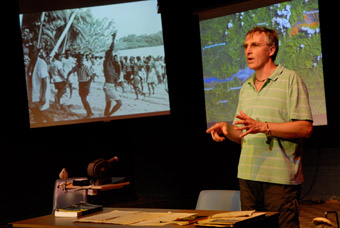reflections on reconciliation
caroline wake: the bougainville photoplay project

Paul Dwyer, Bougainville Photoplay Project
photo Heidrun Löhr
Paul Dwyer, Bougainville Photoplay Project
THE SLIDE NIGHT MIGHT BE DYING IN THE SUBURBS, THANKS TO THE RISE OF DIGITAL PHOTOGRAPHY AND FLICKR, BUT IT STILL PERSISTS ON THE STAGE—ALBEIT IN A SLIGHTLY MORE ELEGANT FORM—THROUGH THE WORK OF PERFORMERS SUCH AS WILLIAM YANG AND NOW PAUL DWYER IN HIS SHOW THE BOUGAINVILLE PHOTOPLAY PROJECT. LIKE YANG, DWYER TELLS INTIMATE TALES THAT BELIE THEIR LARGER POLITICAL SIGNIFICANCE AND HE DOES SO WITH SIMILAR RESTRAINT, SHARING EMOTIONAL STORIES WITHOUT NECESSARILY EMOTING.
Sitting at a desk on a small trapezoidal stage, surrounded by computers on his right (manned by video artist Sean Bacon and director David Williams), a wall of maps and old newspaper articles on his left and two screens above his head, Dwyer braids together three narrative threads: the story of his late father, the orthopaedic surgeon Dr Allan Dwyer, and his pro bono work in Bougainville in the 1960s; the story of Dwyer’s own academic research there 40 years later; and the broader history of Bougainville itself.
Dwyer tells us about his father’s “beautiful hands”, his revolutionary screw and cable treatment for scoliosis (variously illustrated with x-rays, photographs, an onstage skeleton and a reenactment where the scalpel is a black marker pen), his smoking habit, and most importantly his work in Bougainville. The surgeon made several trips there during the 1960s and we relive them in all their Kodachrome glory with photos, slides and snippets of film as well as some amusing excerpts from the notebook of Dwyer’s then 13-year-old brother who recounts a tale of window seats, lost jackets and slightly clammy pants.
The father passed away before Dwyer had the opportunity to accompany him to Bougainville, however he followed in his footsteps in 2004 when he went on a fieldtrip as part of his research into restorative justice and the performative ceremonies associated with it. Like his brother, Dwyer is endearingly frank, particularly about the practice of fieldwork: he reads out the first polite, hesitant email; lurches through a language lesson; and enacts encounters in Tok Pisin and English. He is also honest about his dependence on the good will of his informants, his efforts to build rapport (Rugby League comes in handy) and his self-consciousness about the colonial connotations and the postcolonial context of the whole ethnographic enterprise.
These themes are dealt with more explicitly in the third strand of this story, which rehearses the history of Bougainville’s mine, its war and now its peace. Dwyer explains how the copper mine devastated the local community and why it lead to the rise of the Bougainville Revolutionary Army (BRA) and the retreat of the Papua New Guinea Defence Force, which then funded—with Australia’s assistance—various militia collectively called the Resistance. This long and brutal civil war only came to an end in 1998 and since then Bougainvilleans have worked hard to keep the peace and attain autonomy. The performance ends with Dwyer attending a reconciliation ceremony with more than a thousand participants, who witness perpetrators crossing the circle to apologise to their victims, shake hands and begin to forgive each other.
In his program notes, Dwyer suggests “there is something to be learned from the people of Bougainville about how to do reconciliation” but there is something to be learned from him too. In telling three stories of reconciliation, Dwyer causes us to reflect on the nature of reconciliation itself. In Bougainville, reconciliation emerges as a generous intersubjective encounter and a genuine attempt to right a wrong. Between Bougainville and Australia reconciliation resembles resignation, as if Australia were too preoccupied with its internal reconciliations to contemplate an international one right now. Finally, there seems to be a smaller reconciliation—or reckoning—between Paul Dwyer and his father. More than once, he cites John Berger’s classic, A Fortunate Man: The Story of a Country Doctor, and asks “How does the cure of serious illness compare in value with one of the better poems of a minor poet? How does making a correct but extremely difficult diagnosis compare with painting a great canvas?” The implicit question here is, “How does one compare doctors? How does an MD compare to a PhD?” Perhaps it is indicative of the measurements we all make at some point: how do I compare to my parents, my peers, my neighbours? What is it to be the fortunate child of a fortunate man or the citizen of the so-called lucky country? To whom do we owe a duty of care? To whom do we owe an apology?
Version 1.0 in association with Tamarama Rock Surfers and Paul Dwyer, Bougainville Photoplay Project, devisor and performer Paul Dwyer, director David Williams, video artist Sean Bacon, lighting designer Frank Mainoo, technical assistance Russell Emerson; Old Fitzroy Theatre, Sydney, October 14-31
RealTime issue #94 Dec-Jan 2009 pg. 42






